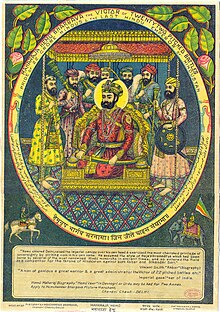Haryanvi people
| Regions with significant populations | |
|---|---|
| India ( Haryana, Delhi ) | |
| Languages | |
| Haryanvi, Hindi | |
| Religion | |
| Predominantly: | |
| Related ethnic groups | |
| Indo-Aryan peoples |
The Haryanvi are an Indo-Aryan-speaking ethnolinguistic group or a Demonym native to Haryana, in northern India. They speak Haryanvi and other similar dialects such as Ahirwati ,Mewati ,Bagri.[1][2][3][4]
History
Haryana has been inhabited since pre-historic period. During the Bronze Age period Haryana was part of Indus valley civilization. Rakhigarhi, Bhirrana are oldest sites of Indus valley civilization.[5] Haryana was part of Kuru Kingdom during 1200 BCE.[6][7] [8]

Pushyabhuti dynasty ruled Haryana region in 7th century with its capital at Thanesar. Harsha was a prominent king of the dynasty.[9] Tomara dynasty ruled the Haryana region in 10th century.[10]
In 1398, Timur attacked and sacked the cities of Sirsa, Fatehabad, Sunam, Kaithal and Panipat.[11][12]

Hem Chandra Vikramaditya claimed royal status after defeating Akbar's Mughal forces on 7 October 1556 in the Battle of Delhi. The area that is now Haryana has been ruled by some of the major empires of India. In the First Battle of Panipat (1526), Babur defeated the Lodis. In the Second Battle of Panipat (1556), Akbar defeated the local Haryanvi Hindu Emperor of Delhi, who belonged to Rewari. Hem Chandra Vikramaditya had earlier won 22 battles across India from Punjab to Bengal, defeating Mughals and Afghans. Hemu had defeated Akbar's forces twice at Agra and the Battle of Delhi in 1556 to become the last Hindu Emperor of India with a formal coronation at Purana Quila in Delhi on 7 October 1556. In the Third Battle of Panipat (1761), the Afghan king Ahmad Shah Abdali defeated the Marathas.[14]
Haryana state came into existence on 1 November 1966 after the Punjab Reorganisation Act (1966) passed.[15]
Castes and Communities
The main communities in Haryana are Jat, Ahir, Brahmin, khatik, Gujjar, Rajput, Agarwal, Harijan, Bishnoi etc. Majority of Muslims in Haryana are Meo .[16]
Culture
Cuisine
Haryana is agricultural state known for producing foodgrains such as wheat, barley, pearl millet, maize, rice and high-quality dairy. Daily village meal in Haryana consist of a simple thali of roti, paired with a leafy stir-fry (saag in dishes such as gajar methi or aloo palak), condiments such as chaas, chutney, pickles. Some known Haryanvi dish are green choliya (green chickpeas), bathua yogurt, bajre ki roti, sangri ki sabzi (beans), kachri ki chutney (wild cucumber) and bajre ki khichdi. Some sweets are panjiri and pinni prepared by unrefined sugar like bura and shakkar and diary. Malpua are popular during festivals.[17][18]
Folk music
Folk music is integral part of Haryanvi culture. Folk song are sung during occasion of child birth, wedding, festival, and Satsang (singing religious songs).[2]
Notable People
- Lakhmi chand, poet, folk singer
- Baje Bhagat, poet and writer
- Subhash Chandra, Media person and Politician
- Dushyant Chautala, Politician
- Jat Mehar Singh Dahiya, poet and freedom fighter
- Yogeshwar Dutt, Wrestler
- Hemu, King
- Juhi Chawla, Actress
- Sunil Grover, Actor and Comedian
- Randeep Hooda, Actor
- Ramdev, Yoga guru
- Arvind Kejriwal, Politician
- Sushil Kumar, wrestler
- Babita Kumari, wrestler
- Bansi Lal, Politician
- Sakshi Malik, wrestler
- Dayachand Mayna, Poet and freedom fighter
- Saina Nehwal, Badminton player
- Gajendra Phogat, Singer
- Geeta Phogat, wrestler
- Mahavir Singh Phogat, wrestler
- Priyanka Phogat, wrestler
- Ritu Phogat, wrestler
- Vinesh Phogat, wrestler
- Rajkummar Rao, Actor
- Virender Sehwag, Cricket Player
- Mallika Sherawat, Actress
- Vijender Singh, boxer
- Anangpal Tomar, King of Haryana
References
- ^ "The way tough Haryanvis speak". tribuneindia. 28 December 2019. Retrieved 28 March 2020.
- ^ a b "Social Status of a Haryanvi Rural Woman: A Reflective Study through Folk Songs". iitd.ac.com. Retrieved 28 March 2020.
- ^ https://www.tribuneindia.com/news/archive/features/no-takers-in-their-own-land-753271
- ^ https://www.pressreader.com/india/hindustan-times-gurugram/20181224/281629601383742
- ^ Singh, Upinder (2008). A History of Ancient and Early medieval India: from the Stone Age to the 12th century. New Delhi: Pearson Education. p. 137. ISBN 978-81-317-1120-0.
- ^ Pletcher 2010, p. 63.
- ^ Witzel 1995, p. 6.
- ^ Witzel 1995.
- ^ Hans Bakker 2014, p. 79.
- ^ Upinder Singh 2008, p. 571.
- ^ Elliot, Sir Henry Miers; Dowson, John (1871). The History of India, as Told by Its Own Historians. The Muhammadan Period: Ed. from the Posthumous Papers of the Late Sir H. M. Elliot . Trübner and Company. pp. 427–31.
- ^ Phadke, H.A. (1990). Haryana, Ancient and Medieval. Harman Publishing House. p. 123.
- ^ Sarkar 1960, p. 66.
- ^ Arnold P. Kaminsky; Roger D. Long (2011). India Today: An Encyclopedia of Life in the Republic. ABC-CLIO. p. 300. ISBN 978-0-313-37462-3.
- ^ the punjab reorganisation act, 1966 - Chief Secretary, Haryana (PDF), retrieved 12 November 2015
- ^ Bansi Lal, Chief Minister of Haryana.
{{cite book}}: Cite has empty unknown parameter:|1=(help) - ^ "Haryanvi thali: Not just 'dhaba' fare". livemint. 4 May 2018. Retrieved 28 March 2020.
- ^ "Haryanvi Food: All the best dishes to try from the cuisine". republicworld. 16 November 2019. Retrieved 28 March 2020.
